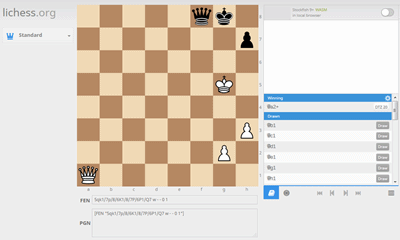

Some of the lines are truly bizarre, such as the kbbbnkrn_3000 position 3B4/k1B5/3N4/7r/8/6B1/8/1K5n where it takes White over 260 moves to capture the black knight trapped on h1, while avoiding Black sacrificing his rook for the white knight. The endings krbbnkqn and kbbnnkrb appear twice, with different bishop parities. Many lines contain reciprocal zugzwangs, which are labeled “zz”. The longest ending without promoted pieces has 360 moves, in krrbnkqr.

The longest with 400 moves is in krrnkrbb_0020, i.e., Black has two same-colored bishops. The attached file 8man_200.pgn contains 22 endings with winning lines 200 moves or longer.

As another point of reference, Harold van der Heijden’s study database contains positions for just over a quarter of the possible pawnless configurations. While 15% seems like a small subset at first blush, most other piece configurations have large material differences between White and Black so that long lines are unlikely. I have done a number of other consistency tests, but not an exhaustive set, so the results described here should still be considered research.Īfter generating about 15% of the pawnless endings I’m quite confident to have captured the longest ones.
#ENDGAME TABLEBASE 8 PIECES GENERATOR#
My generator matches his numbers exactly. Kirill Kryukov has computed the number of unique legal chess positions for all 8-man endings: Because the 8x8 board has an even number of squares there is no intrinsic difference between white and black squares, so the configuration “abcd” is equivalent to “badc”. For example, krbkbn_1010 indicates same-colored bishops, and krbkbn_1001 indicates opposite-colored bishops. I use a notation which I believe is due to Ken Thompson: the 4-digit number “abcd” denotes a configuration where White has “a” white-squared bishops and “b” black-square bishops, and Black has “c” white-squared bishops and “d” black-squared bishops. Another technical point is that for endings with more than one bishop it is useful to consider the relative colors of the bishops. I don’t consider castling rights and ignore the 50-move rule. This results in 1,632 possible 8-piece configurations for pawnless endings, and a total of 4,795 configurations if pawns are included. Endings of the form kkx are not needed because the number of White wins and Black losses would obviously be exactly zero. As a result, kxky and the “flipped” ending kykx are generally different. The databases are one-sided, meaning they contain only wins for White and losses for Black. I use the Distance to Conversion (DTC) metric, which is the shortest number of moves to either checkmate or capture. My results suggest that we may already be at or close to this saturation point: The longest winning line for 8-man endgames without pawns appears to be “only” 400 moves.įirst some technical preliminaries: The computer algorithm employed is standard retrograde analysis, but using various tricks, largely due to Yakov Konoval, to make the generation feasible for hobby computing. An important question is at what point the chess board becomes so crowded that adding more pieces does not lead to longer winning lines due to the increased likelihood of shortening captures. One key discovery by YKMB is the so far longest winning line of 517 moves in the 7-man endgame kqnkrbn, more than twice the length of the previous record of 243 moves in the 6-man endgame krnknn. In this note I briefly describe my 8-man work, and provide a link to some of the results. It has been about fifteen years since Yakov Konoval and Marc Bourzutschky (YKMB) published the first database results for 7-man endgames, and about thirty years since Lewis Stiller’s pioneering work on 6-man endgames, so as suggested by Moore’s law we are now due for results for 8-man endgames. Marc Bourzutschky did send this email with his first explorations of the fresh 8-men Tablebase.Īn chess endgame tablebase is a database with all the (legal) positions with the outcome, calculated by a chesscomputer program.Īt the end of this email, some endgamestudies are shown where new cooks have been found.Īlso some new findings very long lines are included in this article.Īn interesting contribution to endgame theory.


 0 kommentar(er)
0 kommentar(er)
